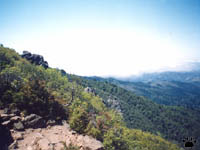
Aplodontia habitat at Point Reyes, California.
Quest for Aplodontia.
| Small mammals are Cinderellas of vertebrate zoology. Everybody else seems to have its fans. Millions of birdwatchers circle the globe in search of god-forsaken local endemics; herp fanatics comb remote deserts and forests for little-known lizards and frogs; fish enthusiasts fill their aquariums with tiniest inhabitants of tropical swamps. But nobody (except for pest extermination services) cares about rare shrews, bats, or rodents. It is not surprising that one of the most interesting North American mammals is almost unknown to general public and naturalists. |
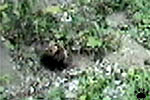
Sometimes A. rufa burrows can be
found alone in the open. Point Arena,
California. | Its English name, "mountain beaver", is misleading. It is not a beaver, and lives all the way down to sea level. Its scientific name, Aplodontia rufa, isn't any better: the animal isn't red, and its teeth are not particularly shiny. It's old name, "sewellel", isn't used anymore. | 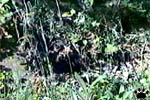
But usually they occur in groups
amidst dense vegetation. Point
Reyes, California. |
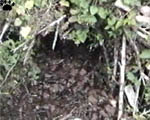
Unlike most subterranean rodents,
Aplodontia prefers to have its
burrows vet or even partly flooded.
Sometimes it diverts small streams
to make them flow through its
tunnels. Lolo Pass, Oregon. | It is not rare or local: this creature occurs from extreme southwestern Canada to Sierra Nevada of California, and is particularly common in western Oregon and Washington. It can be found in forests, gardens, city parks, even coastal dunes. But it spends most of time underground and is very difficult to see. Large burrows are often the only visible sign of its presence. | 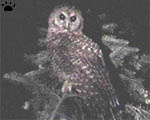
Spotted owl (Strix occidentalis) and
other predators hunt A. rufa.
As a result, these rodents can be very
shy. Often the sound of a camera
switch is all they need to
disappear underground for an hour. |
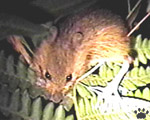
While searching for Aplodontia,
I encountered numerous other animals
living or temporarily hiding in its
burrows: salamanders, insects, toads,
swallows, shrews, and many kinds
of smaller rodents. | For me, seeing "mountain beaver" became almost an obsession. With the exception of a few very small and local species, it was the only North American mammal I hadn't seen in the wild. It couldn't be observed in a zoo (it doesn't do well in captivity). Besides, it is a unique "living fossil", believed to be the most ancient form of more than two thousands existing rodents. | 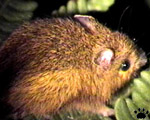
This one is Pacific jumping mouse
(Zapus trinotatus), videotaped in
Aplodontia colony at Patrick's
Point, California. These tame
insectivorous creatures are actually
not mice, but relatives of jerboas. | 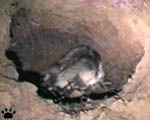
Bushy-tailed woodrat (Neotoma
cinerea), sleeping in an old
Aplodontia burrow. Humboldt
Lagoons State Park, California. | I spent countless nights patrolling brushlands and woods of California and Oregon, never seeing more than a glimpse of something hairy disappearing into a burrow. Finally, Dale Steele, the leading (and almost only) expert on this animal, told me about a particularly good site at the slopes of Mount Hood near Portland. | 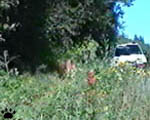
Prime habitat of Aplodontia rufa
at Lolo Pass near Mount Hood,
Northern Oregon. This tiny roadside
meadow is riddled with burrows. | 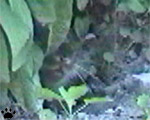
Smelling and listening to possible
danger before coming out of the
burrow. Lolo Pass, Oregon. | Here, "mountain beavers" colonized dense shrubs growing under a powerline. Some colonies are very close to a road. I spent 12 hours sitting motionless in front of one particularly impressive group of burrows. During this time, the animals spent less than 5 minutes above ground, mostly in the last 2 hours before sunset. | 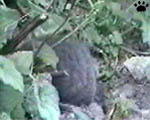
Aplodontia disappearing in its
burrow. The animal has no visible
tail. Lolo Pass, Oregon. | 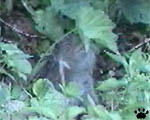
"Mountain beavers" feed on many
kinds of plants, from grasses to small
trees, and are said to be surprisingly
good climbers. Lolo Pass, Oregon. | However, I had a lot of fun watching them feeding, running, even fighting (there was one spectacular fight, but I couldn't get it on tape). I got about 30 seconds of video, from which most still pictures on this page were taken. Here is this video: | 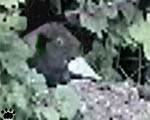
Often they would drag some plant
material into a burrow before
eating it or storing it into a cache.
Lolo Pass, Oregon. | 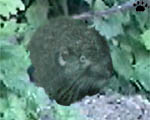
Like most subterranean rodents,
Aplodontia has small eyes and ears,
but impressive whiskers. Lolo Pass. | Aplodontia are mysterious animals, full of biological peculiarities. They have primitive thermoregulation and kidneys, they serve as hosts to world's largest fleas, they live in dense colonies but appear to have no social structure to speak of. We are lucky to have these creatures still with us, lone survivors of times long past. | 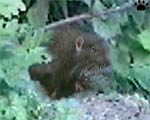
However, it seems to have not only
acute sense of smell, but also decent
hearing and eyesight. Lolo Pass. | 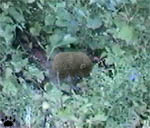
"Mountain beavers" are very cute, but
they don't make good pets. They are
very nasty if caught, and seldom
survive in captivity. Lolo Pass. | Unfortunately, two isolated races (probably separate species) of "mountain beavers" are already endangered. They survive at two peninsulas in Northern California (Point Reyes and Point Arena), where they are threatened by habitat loss and possibly climate warming. They tend to be blackish rather than gray. This animal is also legally protected in Canada, but considered garden pest in Oregon and Washington. | 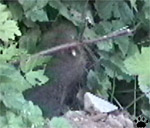
Unlike most mammals feeding on
green vegetation, Aplodontia doesn't
seem to spend much time eating.
Why? Nobody knows. Lolo Pass. | Dale Steele's Aplodontia web site
Sunset at Mt. Hood, Oregon.
Home |